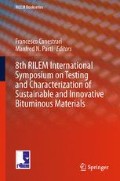Abstract
The purpose of this study is to evaluate how different binders react with polyphosphoric acid (PPA), and to contribute to a better understanding of this interaction. A number of bituminous binders were characterized before and after adding PPA, using rheological and chemical test methods, including FT-IR, uv-vis spectroscopy, NMR and gel permeation chromatography. The interaction with PPA is quantified as the change in softening point after adding a specific percentage of PPA. Most bitumen show an increase in R&B. Also in rheology, the stiffness increases, while the phase angle decreases when adding PPA. These observations are well-known and have been reported frequently by other authors. However, for one of the binders, small amounts of PPA lead to a decrease in R&B and to an increase in penetration. Rheological tests on this binder confirmed that the complex modulus decreases after adding PPA. These effects could be attributed to a precipitation, induced by PPA. This is very clear when investigating a drop of the bitumen-PPA blend in an optical microscope, and is also confirmed by storage stability tests. In conclusion, the findings suggest that PPA interacts with conjugated aromatic compounds, and this can in some cases lead to a precipitation.
Access this chapter
Tax calculation will be finalised at checkout
Purchases are for personal use only
References
Andrews A B, Edwards J C, Pomerantz A E, Mullins O C, Nordlund D, Norinaga K (2011) Comparison of Coal-Derived and Petroleum Asphaltenes by 13C Nuclear Magnetic Resonance, DEPT, and XRS. Energy & Fuels 25(7):3068.
Baumgardner GL (2010) Why and how of polyphosphoric acid modification - An industry perspective. AAPT 79:663-678.
Baumgardner GL, Masson J-F, Hardee JR, Menapace AM, Williams AG (2005) Polyphosphoric Acid Modified Asphalt: Proposed Mechanisms. AAPT 74:284-308.
De Filippis P, Giavarini C., Scarsella M. (1995), Improving the ageing resistance of straight-run bitumens by addition of phosphorus compounds. Fuel 74(6):836-841.
De Filippis P, Giavarini C, Scarsella M (1996) Integrated process for stabilization and upgrading of residues and bitumens. Fuel Science and Technology International 14 (6):821-838.
Edwards Y, Tasdemir Y, Isacsson U (2006) Influence of commercial waxes and polyphosphoric acid on bitumen and asphalt concrete performance. Materials and Structures 39(291):725-737.
Fee D, Maldonado R, Reinke G, and Romagosa H (2010) Polyphosphoric Acid Modification of Asphalt. Transportation Research Record 2179:49-57.
Huang S-C, Turner TF, Miknis FP, Thomas KP (2008) Long-term aging characteristics of polyphosphoric acid-modified asphalts. Transportation Research Record 2051:1-7.
Le Guern M, Chailleux E, Farcas F, Dreessen S, Mabille I (2010) Physico-chemical analysis of five hard bitumens: Identification of chemical species and molecular organization before and after artificial aging. Fuel 98:3330-3339.
Miknis FP, Thomas KP (2008) NMR analysis of polyphosphoric acid-modified bitumens. Road Materials and Pavement Design 9(1):59-72.
Masson J-F (2008) Brief review of the chemistry of polyphosphoric acid (PPA) and bitumen. Energy and Fuels 22(4):2637-2640.
Orange G, Dupuis D, Marin J V, Farcas F, Such C, Marcant B (2004) Chemical Modification of Bitumen through Polyphosphoric Acid. 3rd E& E Congress Paper 334:733-745.
Romagosa EE, Maldonado R, Fee D, Dongré, R, Reinke G (2010) Polyphosphoric acid binder modification. AAPT 79:743-771.
Redelius P, Soenen H (2014) Relation between bitumen chemistry and performance. Fuel published online DOI: 10.1016/j.fuel.2014.09.044.
Singh D, Kothiyal V, Kapoor MP., Ramaswamyt V, Aloopwan MKS (1993) Structural changes during visbreaking of light Arabian mix short residue. Fuel 72(6):751-754.
Author information
Authors and Affiliations
Corresponding author
Editor information
Editors and Affiliations
Rights and permissions
Copyright information
© 2016 RILEM
About this paper
Cite this paper
Soenen, H., Heyrman, S., Lu, X., Redelius, P., Edwards, J.C. (2016). The Interaction of Polyphosphoric Acid with Bituminous Binders. In: Canestrari, F., Partl, M. (eds) 8th RILEM International Symposium on Testing and Characterization of Sustainable and Innovative Bituminous Materials. RILEM Bookseries, vol 11. Springer, Dordrecht. https://doi.org/10.1007/978-94-017-7342-3_9
Download citation
DOI: https://doi.org/10.1007/978-94-017-7342-3_9
Published:
Publisher Name: Springer, Dordrecht
Print ISBN: 978-94-017-7341-6
Online ISBN: 978-94-017-7342-3
eBook Packages: EngineeringEngineering (R0)

